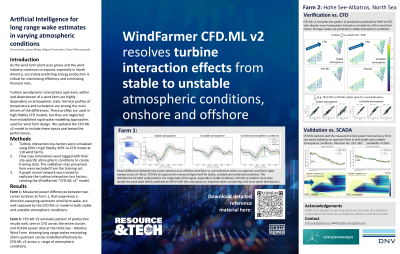Back

Artificial Intelligence for long range wake estimates in varying atmospheric conditions
Tuesday, October 1, 2024
5:00 PM – 6:00 PM MST
Location: Regency D


Tom Levick, MPhys
WindFarmer Modelling Lead
DNV, England, United Kingdom
Poster Presenter(s)
Presentation Description: For wind farm projects within larger wind farm clusters, we expect greater pre-construction energy assessment uncertainty related to wake and blockage impacts. Furthermore, the site-specific boundary layer composition impacts wake and blockage losses, but these factors are not included in established wake models.
DNV’s RANS CFD model has been upgraded to consider site specific atmospheric conditions predicted by the Weather Research and Forecasting (WRF) model. WRF-RANS-CFD has since been shown to accurately predict wind farm flows across today’s large offshore wind farm clusters. However, WRF-RANS-CFD is a computationally intensive solution, so DNV trained a Graph Neural Network (GNN) to emulate the RANS CFD predictions of turbine interaction loss factors, producing a model fast enough to use in a layout optimization process: CFD.ML
We describe the training of a new “multi-stability” GNN, considering new input parameters that describe the relevant atmospheric influences, including turbulence, shear, thermal stratification, boundary layer height, and the Coriolis effect.
We will demonstrate how “multi-stability” CFD.ML predicts the variations in turbine interaction loss as influenced by changes in the atmospheric conditions. Firstly, we will present a sensitivity study with verification against RANS CFD results. A hypothetical project is used, and the atmospheric boundary layer properties are varied.
Secondly we will share a validation against SCADA power measurements to show how the inclusion of the new parameters improves long-range wake impact predictions. We compare measured power production patterns on the front row of an offshore wind farm within the wake of an upstream wind farm to that predicted by our model.
DNV’s RANS CFD model has been upgraded to consider site specific atmospheric conditions predicted by the Weather Research and Forecasting (WRF) model. WRF-RANS-CFD has since been shown to accurately predict wind farm flows across today’s large offshore wind farm clusters. However, WRF-RANS-CFD is a computationally intensive solution, so DNV trained a Graph Neural Network (GNN) to emulate the RANS CFD predictions of turbine interaction loss factors, producing a model fast enough to use in a layout optimization process: CFD.ML
We describe the training of a new “multi-stability” GNN, considering new input parameters that describe the relevant atmospheric influences, including turbulence, shear, thermal stratification, boundary layer height, and the Coriolis effect.
We will demonstrate how “multi-stability” CFD.ML predicts the variations in turbine interaction loss as influenced by changes in the atmospheric conditions. Firstly, we will present a sensitivity study with verification against RANS CFD results. A hypothetical project is used, and the atmospheric boundary layer properties are varied.
Secondly we will share a validation against SCADA power measurements to show how the inclusion of the new parameters improves long-range wake impact predictions. We compare measured power production patterns on the front row of an offshore wind farm within the wake of an upstream wind farm to that predicted by our model.
